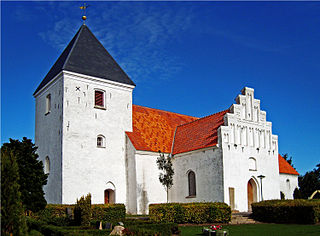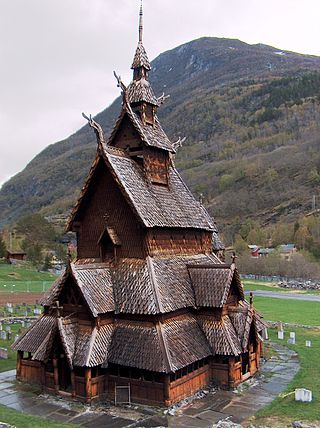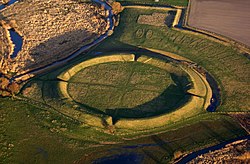
Harald "Bluetooth" Gormsson was a king of Denmark and Norway.

Ringforts or ring forts are small circular fortified settlements built during the Bronze Age, Iron Age and early Middle Ages up to about the year 1000 AD. They are found in Northern Europe, especially in Ireland. There are also many in South Wales and in Cornwall, where they are called rounds. Ringforts come in many sizes and may be made of stone or earth. Earthen ringforts would have been marked by a circular rampart, often with a stakewall. Both stone and earthen ringforts would generally have had at least one building inside.

Maglemosian is the name given to a culture of the early Mesolithic period in Northern Europe. In Scandinavia, the culture was succeeded by the Kongemose culture.

The Danevirke or Danework is a system of Danish fortifications in Schleswig-Holstein, Germany. This historically important linear defensive earthwork across the neck of the Cimbrian peninsula was initiated by the Danes in the Nordic Iron Age about AD 650. It was later expanded multiple times during Denmark's Viking Age and High Middle Ages. The Danevirke was last used for military purposes in 1864 during the Second War of Schleswig.

Viking art, also known commonly as Norse art, is a term widely accepted for the art of Scandinavian Norsemen and Viking settlements further afield—particularly in the British Isles and Iceland—during the Viking Age of the 8th-11th centuries. Viking art has many design elements in common with Celtic, Germanic, the later Romanesque and Eastern European art, sharing many influences with each of these traditions.

Nonnebakken is a hill in Odense, Denmark. It is the site of one of Denmark's six former Viking ring castles, built during the reign of Sweyn Forkbeard, who had forced his father Harold Bluetooth to leave the country and seek refuge with the Jomsvikings on Wollin around 975. The fort enabled its occupier to control the Odense River passing next to the hill.

Aggersborg is the largest of Denmark's former Viking ring fortress, and one of the largest archaeological sites in Denmark. It is located near Aggersund on the north side of the Limfjord. It consists of a circular rampart surrounded by a ditch. Four main roads arranged in a cross connects the fortress center with the rampart's outer ring. The roads were tunneled under the outer rampart, leaving the circular structure intact. Many archaeological excavations have been conducted on the site, revealing its original structure and design. These excavations also uncovered a large number of artefacts from the Iron Age and Viking Age. The surface of the site as it exists today is a reconstruction.

Fyrkat is a former Viking ring castle in Denmark, dating from c. 980 AD. It is located near the town of Hobro, some distance from the present end of the Mariager Fjord in Northern Jutland. The fortress is built on a narrow piece of land, with a stream on one side and swampy area on the other sides. Likely built during the reign of Harald Gormsson or his son Sweyn Forkbeard, the fortress may have served as barracks or as a defensive stronghold. It would have help to enable control of the traffic on the main land-based trading route between Aalborg and Aarhus. Because of its unique architecture and testimony to the strategic power of the House of Knýtlinga, Fyrkat was inscribed on the UNESCO World Heritage List along with four other Viking ring castles in 2023.

Eketorp is an Iron Age fort, located in southeastern Öland, Sweden, and extensively reconstructed and enlarged in the Middle Ages. Throughout the ages the fortification has served a variety of somewhat differing uses: from defensive ringfort, to medieval safe haven and thence a cavalry garrison. In the 20th century it was further reconstructed to become a heavily visited tourist site and a location for re-enactment of medieval battles. Eketorp is the only one of the 19 known prehistoric fortifications on Öland that has been completely excavated, yielding a total of over 24,000 individual artifacts. The entirety of southern Öland has been designated as a World Heritage Site by UNESCO. The Eketorp fortification is often referred to as Eketorp Castle.

Borgeby Castle lies in Lomma Municipality, Scania in southern Sweden, beside the Kävlingeån, the largest river in Scania.

The Trelleborg, west of Slagelse on the Danish island of Zealand, is one of seven known Viking ring castles. When built, the fortress was situated on a peninsula that jutted into the swampy area between two rivers. The swamp was connected to the Great Belt by a lake and could be navigated by Viking ships. Trelleborg is believed to have been ordered by King Harald Bluetooth in the year 980 AD and it might have commanded the Great Belt and its sea traffic, between the islands of Zealand and Funen.

Triangle Region Denmark is a cooperation consisting of seven Danish municipalities on the Danish peninsula of Jutland and the island of Funen: Billund, Fredericia, Haderslev, Kolding, Middelfart, Vejen and Vejle.

Lisbjerg is a village and suburb 7 km north of the city center of Aarhus, Denmark. Lisbjerg has a population of 1,352.

Scania, also known by its native name of Skåne, is the southernmost of the historical provinces of Sweden. Located in the south tip of the geographical region of Götaland, the province is roughly conterminous with Skåne County, created in 1997. Like the other historical provinces of Sweden, Scania still features in colloquial speech and in cultural references, and can therefore not be regarded as an archaic concept. Within Scania there are 33 municipalities that are autonomous within the Skåne Regional Council. Scania's largest city, Malmö, is the third-largest city in Sweden, as well as the fifth-largest in Scandinavia.

A circular rampart is an embankment built in the shape of a circle that was used as part of the defences for a military fortification, hill fort or refuge, or was built for religious purposes or as a place of gathering.

The major aspects of Medieval Scandinavian architecture are boathouses, religious buildings, and general buildings.

Gamleborg, also known as Gamleborg Viking Fortress, was the first fortification on the Danish island of Bornholm. Built around 750 AD, it was the seat of the kings of Bornholm during the Viking age (750–1050) and early Middle Ages (1050–1150). The massive fortress is 264 metres (866 ft) long from north to south and 110 metres (360 ft) wide from east to west, with gates to the north and southwest. Around 1100, significant alterations were made and it was reinforced, but it was abandoned soon afterwards in favour of the fortification of Lilleborg, roughly 700 metres (2,300 ft) to the northeast.

Borgring also known as Vallø Borgring, is a Danish Viking ring fortress located near Køge on the island of Zealand. Likely built around 970 or 980, the fortress may have been built to defend trade routes or as a military barracks. In 2023, along with four other Viking ring fortresses, Borgring was isncribed on the UNESCO World Heritage List for its unique architecture and testimony to the strategic and military power of the House of Knýtlinga.
Tønnesminde is the site of an archaeological excavation ground and present day organic farm on the island of Samsø, Denmark. Archaeological evidence attests the area around Tønnesminde has a long history of human occupation, dating from approximately 4000 BC to present day. Recent excavations suggest that Tønnesminde contains settlements dating from the Funnelbeaker culture in the Early Neolithic period, Early Bronze Age, Pre-Roman Iron Age, and Viking Age.

Else Roesdahl is a Danish archaeologist, historian and educator. She has mediated the history of the Vikings for most of her life, including coordination of notable exhibitions on the Viking Age and authoring several books on the subject. Roesdahl's books have been translated into several languages.
























